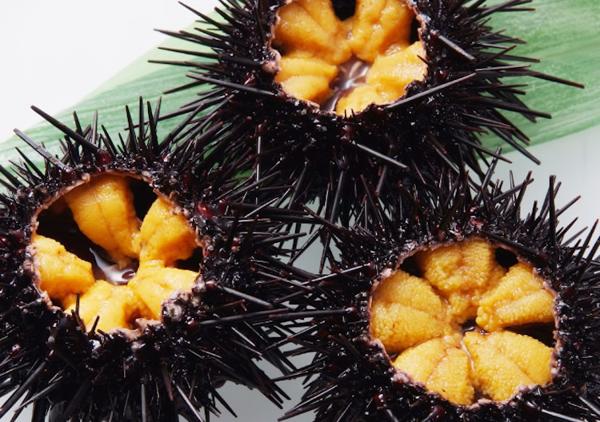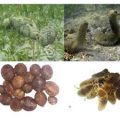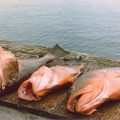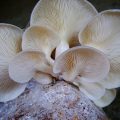Few years ago, sea urchins or what foreign countries tagged as sea porcupines, are generally ignored marine species. It could be because of their strange-looking movable spines and tubular feet akin to starfish that make people stay away from them. People only realized sea urchin’s special value when its demand in foreign markets had overtaken the demand for the more traditional lobster.

In 1995, the worldwide production of sea urchins was estimated at 119,647 metric tons. Their highly priced roe or gonads or what we call locally as alige became the most sought-after marine delicacy for its sweet, tangy and exquisite flavor. In Tokyo wholesale markets, sea urchins gonads are sold at US $58-160/ kg. Japan is said to be the largest consumer of sea urchin gonads, followed by France and Korea.
The increased market demand for sea urchins coupled with favorable economic return had resulted to uncontrolled and non-selective harvesting of the species. One best documented example of sea urchin exploitation was reported in our country, particularly in the municipality of Bolinao, Pangasinan, where residents indiscriminately collected the small, immature urchins even before they spawn or reproduce.
This alarming case had prompted the fishery experts of Marine Science Institute (MSI), University of the Philippines Diliman to develop a grow-out culture technology for sea urchins not only to conserve and sustain the urchins’ population but also to provide lucrative business opportunities for small and large fishery operators.
Getting used to sea urchins
Just like any other marine species, sea urchins have distinct biological features that need to be thoroughly understood by the growers.
In our country, the most common sea urchin species is Tripneustes grantilla locally known as swaki, santol-santolan, maritangtang and kuden-kuden and found in the Ilocos and Bicol regions. Their purplish-brown body has numerous short white-and-orange spines. They live on the sea floor and feed on sargassum, a brown seaweed.
Sea urchins have two distinct phases in their life cycle: the planktonic larval stage that lasts 5-8 weeks and benthic adult stage, wherein the urchins reach sexual maturity at 7-8 months after fertilization.
It is hard to distinguish males from female sea urchins by simply looking at their external appearance. One may determine the sex by shucking the urchins and examining the color and texture of the gonads. The gonads are the edible part of the animal that contain sex cells and gametes. Each urchin has five strips of gonads between the rows of its tube feet. The female gonads are orange with granular egg; while the gonads of males are yellow with cream-yellow sperms.
Sea urchins spawn or release eggs year-round in their two to three-year lifespan.
The Grow-out procedure
According to the researchers of the study, one should do an initial survey in the prospective grow-out site while making sure that sea urchin brood stock is abundant in the area.
For the construction of the cage, the most durable materials locally available are PVC pipe frames covered with green polyethylene screen or net. These cages are installed on the seafloor by tying the four corners of the net to bamboo stakes. The cage should be elevated at least one foot above the seafloor and the top should be about 0.5 m below the sea water surface during low tide.
When the source of seed stock is far from the grow-out area, proper transporting procedure should be strictly followed. Live sea urchins while in transport should be kept in Styrofoam iceboxes (with aerators similar to aquarium’s) that contain seawater. About 500-600 urchins can be placed in one Styrofoam box. It is recommended to transport the seedstock early in the morning when the temperature is lower. Sea urchins, regardless of how they are transported, should not be abruptly transferred from the transport containers directly to the sea cages because sudden change in water conditions can further stress the urchins and may cause them to die.
The ideal number of sea urchin per cage should not exceed 500 because too crowded grow-out cage results to competition. Even if they are always supplied with sargassum, their growth will not be uniform thus stunted individuals yield smaller gonads.
In sea urchin culture, proper care and maintenance should not be only limited to the animals. One should also be “responsible” in taking care of the urchins’ source of food. Sargassum, when indiscriminately stripped may result to eventual denudation of algal bed. One proper way of harvesting sargassum is by using a sharp knife or sickle to selectively harvest the plant’s secondary branches. This practice will leave the roots and the primary axis of plant intact, thus letting the plant to regenerate for future harvesting.
Sea urchins are fed with sargassum once or twice a week. There should be enough amount of sargassum left in the cage to ensure that urchins feed at maximum rates, grow faster, and consequently develop large gonads.
One advantage of rearing sea urchins over other aquaculture species is that they don’t require regular monitoring. Monitoring is only deemed useful if one wants to periodically check on the growth performance of the sea urchins.
In a grow-out trial conducted to determine the rate of survivorship of the urchins, experts found that 85% of the population successfully survived. They explained that the sea urchins survival rate is relatively high mainly due to few known parasitic diseases for sea urchin.
One remarkable characteristic of sea urchins is that they grow very rapidly but gradually tapers off when they become larger. Because of this, thinning out of the population is required. It is recommended to build additional cages for splitting the stocking density, especially in the last month prior to harvesting, where urchins are in “fattening phase”. During this stage, the ideal number of sea urchins should be maintained at 200 individuals per sq m. They should always be given high food rations.
On harvesting
The right time to harvest sea urchins is when they reach a diameter of 7-8 cm. To ensure maximum yield, it is best to harvest the sea urchins before they spawn, because urchins that are close to spawning have large, firm gonads. One technique of determining if the urchins have large gonads is shucking about 10-20 urchins. If the gonads are filled with nutritive cells or ripe sperms or eggs, it is an indicator that the urchins are close to spawning. But if more than half of the samples have thin and watery gonads, it is an indicator that the urchins have already spawned. If this is the case, it is recommended to wait another 2-3 weeks before harvesting.
——————
Reference:
Sea Urchin Grow-out Culture – a study funded by DA-Bureau of Agricultural Research
For more information, please contact, Dr. Marie Antonette Junio-Meñez, UP Marine Science Institute, UP Diliman, Quezon City at Tel. No. (02) 9223921; 9205301
by Mary Charlotte Fresco, BAR Chronicle, July 2002 Issue (Vol. 3 No. 13)





